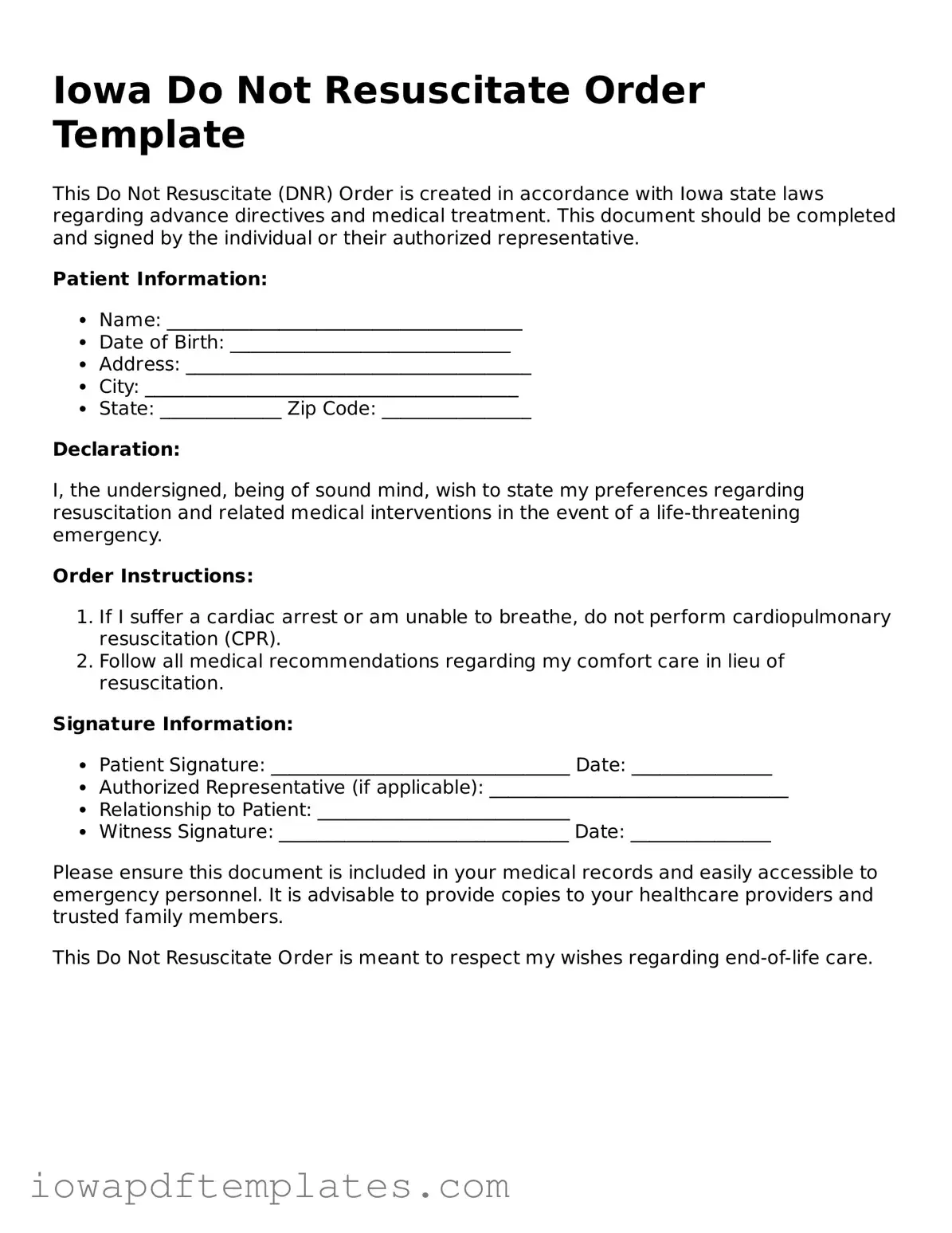The Iowa Do Not Resuscitate (DNR) Order form shares similarities with the Advance Directive. An Advance Directive is a legal document that outlines a person's wishes regarding medical treatment when they are unable to communicate. Like the DNR, it allows individuals to express their preferences about life-sustaining measures, ensuring that their healthcare aligns with their values and desires. Both documents aim to provide clarity to healthcare providers and family members during critical situations.
Another document akin to the DNR is the Living Will. This legal document specifically details the types of medical treatments a person would or would not want at the end of life. While the DNR focuses on resuscitation efforts, the Living Will can encompass a broader range of medical decisions. Both documents empower individuals to make choices about their medical care, fostering autonomy in healthcare decisions.
The Physician Orders for Life-Sustaining Treatment (POLST) form is also similar to the DNR. POLST is a medical order that reflects a patient’s preferences regarding treatment at the end of life. Unlike the DNR, which primarily addresses resuscitation, POLST can include directives about other interventions, such as feeding tubes or antibiotics. Both documents are intended to communicate a patient’s wishes to healthcare providers, ensuring that those wishes are honored.
Healthcare Power of Attorney (POA) documents share a connection with the DNR as well. A Healthcare POA designates a person to make medical decisions on behalf of someone else if they become incapacitated. While the DNR specifically addresses resuscitation, the Healthcare POA can encompass a wider range of medical decisions. Both documents are crucial for ensuring that an individual's healthcare preferences are respected when they cannot advocate for themselves.
The Comfort Care Order is another document that parallels the DNR. This order focuses on providing comfort and pain relief rather than aggressive medical interventions. While the DNR prevents resuscitation efforts, the Comfort Care Order emphasizes the importance of quality of life in the final stages of life. Both documents reflect a patient’s desire to prioritize comfort over invasive treatments.
Similar to the DNR, the Do Not Intubate (DNI) order specifically addresses a patient’s wishes regarding intubation, a procedure used to assist with breathing. While a DNR prohibits resuscitation efforts, a DNI indicates that a patient does not want to be placed on a ventilator. Both documents are essential for guiding healthcare providers in respecting a patient’s end-of-life wishes.
The Medical Orders for Life-Sustaining Treatment (MOLST) form also resembles the DNR. Like POLST, MOLST serves as a medical order that conveys a patient’s treatment preferences. Both documents aim to ensure that healthcare professionals honor the patient’s choices regarding life-sustaining measures, promoting a patient-centered approach to care.
For those looking to understand the foundational components of their business, a thorough examination of the aspects surrounding the Operating Agreement is crucial. This document not only clarifies management responsibilities but is also pivotal in ensuring operational efficiency. For a more in-depth look, visit key information on the Operating Agreement essentials.
Another related document is the End-of-Life Care Plan. This plan outlines a patient’s preferences for care as they approach the end of life. While the DNR focuses on resuscitation, the End-of-Life Care Plan can cover a range of topics, including pain management and emotional support. Both documents are designed to provide guidance to healthcare providers and loved ones during critical times.
The Palliative Care Plan is similar to the DNR in that it emphasizes comfort and quality of life for patients with serious illnesses. This plan outlines the goals of care, including pain management and symptom relief, rather than aggressive life-saving measures. Both documents reflect a commitment to ensuring that patients receive care aligned with their values and preferences.
Finally, the Hospice Care Agreement shares similarities with the DNR. This agreement is made when a patient chooses to receive hospice care, focusing on comfort and quality of life rather than curative treatments. While the DNR specifically addresses resuscitation, the Hospice Care Agreement encompasses a broader approach to end-of-life care, prioritizing the patient’s wishes and well-being. Both documents aim to provide a clear framework for healthcare decisions during life’s final stages.
